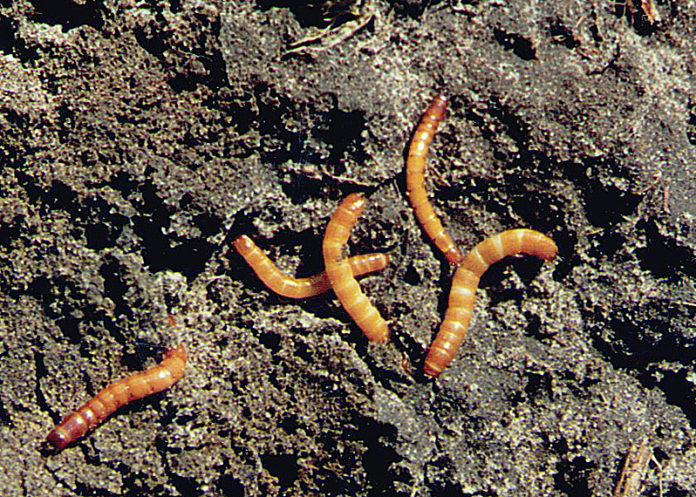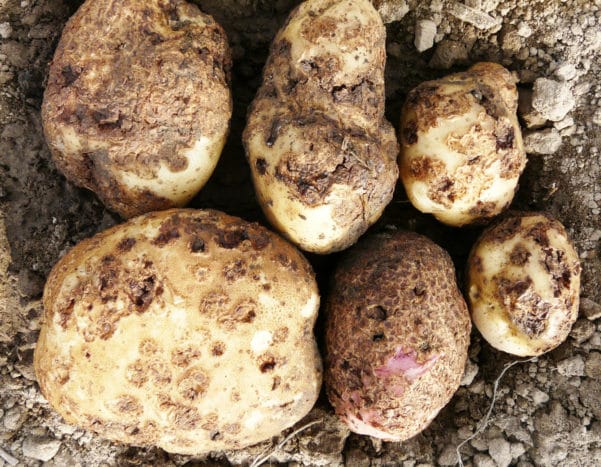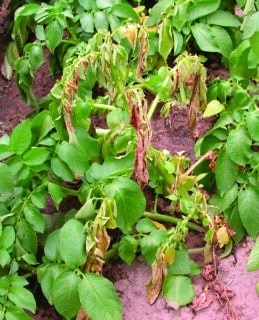
Use this handy checklist to get ready for potato planting this spring.
The potato is a challenging crop to grow and requires intensive management for success. Much is in the hands of Mother Nature, but problems in the field can exacerbate problems with pests. Soil texture, soil compaction and soil organic matter all have a significant impact on crop development. Be prepared.
There are management practices which will reduce the problems with pests. What follows is a check list of things to remember before planting.
- Conduct complete soil tests. Soil tests are necessary to determine the right rate of fertilizer to apply. Under- or over-fertilizing can encourage diseases and limit yield.
- Check for nematodes, wireworms and white grubs before planting. Take soil samples for nematode counts and use baits to trap wireworms. If wireworm populations are high, use Cimegra at planting. White grubs are usually easy to see when plowing the soil in the spring.
Verticillium.jpg — Verticillium is caused by not growing early susceptible varieties, proper insect control and keeping adequate soil fertility and soil moisture. Photo: Eugenia Banks - Analyze soil samples for Verticillium before planting. If Verticillium levels in a field are medium to high, do not plant early or susceptible varieties like Superior, Envol, or Goldrush. The FL varieties seem to have good tolerance to Verticillium.
- If the field is infested with common scab, grow only resistant varieties.
- If planting where pink rot has occurred before, apply Orondis as an in-furrow spray.
- If you are renting land, be aware of previous crops and problem weeds. Some of the herbicides used on field crops can persist for years at levels that will damage potatoes.
- Aim for soil of good tilth without drying out the soil or producing soil clods. Tillage that dries out the soil surface reduces plant vigour. Also, sufficient tillage is required to incorporate pre-emergence herbicides.

- Plant only certified, healthy seed. Always check seed upon arrival. Select a seed sample at random, not just from the face of the pile at the back of the truck. Wash the sample and check for common scab, powdery scab, black dot, Fusarium and late blight. You have only 48 hours to contact the Canadian Food Inspection Agency if you detect seed problems.
- Calibrate the seed cutter. Sharpen knives and sanitize cutting equipment at least once a day and/or when changing seed lots to avoid spreading diseases like dry rot, blackleg and soft rot.
- Warm seed tubers to 10 to 13 C before cutting. This reduces bruising when handling, promotes rapid healing of cut surfaces and initiates sprouts before planting.
- Apply the fungicide/insecticide seed treatments you know will be cost effective.
- Use B-size seed for early planting, if possible. Whole seed tolerates cool, wet conditions better than cut seed and is more resistant to soft rot.
- Destroy slivers and any tuber waste left after cutting.
- Try to schedule planting to coincide with favourable soil and weather conditions. Ideally, seed and soil should be the same temperature at planting. Don’t plant cold seed in warm soil. The seed will sweat, and this creates favorable conditions for soft rot.
- Apply seed treatments and in-furrow pesticides depending on anticipated problems.
- Check the depth and spacing of seed pieces at the beginning of planting and several times while planting. Skips and clumped seed pieces reduce yields. Doubles reduce average tuber size. Plants adjacent to skips don’t fully compensate for the missing neighbour.
- Eliminate cull piles and volunteers from last year’s fields. Volunteers can serve as a source of late blight inoculum all season long. Colorado potato beetles (CPB) can build up tremendous populations on volunteer plants. Volunteers serve as the host for early emerging beetles. Although defoliation of volunteers can be seen as a benefit, the CPB may move to nearby commercial fields once the volunteers are defoliated. This can result in a vigorous second generation of beetles.
Remember — an ounce of prevention is worth a pound of cure!
Header Photo — Wireworms can be prevented by applying a preventative insecticide at planting such as Cimegra. Photo: Eugenia Banks
Related Articles
Managing Verticillium Wilt — Canadian Spud Congress Spotlight









